Rohith MV
Motion-Guided Masking for Spatiotemporal Representation Learning
Aug 24, 2023Abstract:Several recent works have directly extended the image masked autoencoder (MAE) with random masking into video domain, achieving promising results. However, unlike images, both spatial and temporal information are important for video understanding. This suggests that the random masking strategy that is inherited from the image MAE is less effective for video MAE. This motivates the design of a novel masking algorithm that can more efficiently make use of video saliency. Specifically, we propose a motion-guided masking algorithm (MGM) which leverages motion vectors to guide the position of each mask over time. Crucially, these motion-based correspondences can be directly obtained from information stored in the compressed format of the video, which makes our method efficient and scalable. On two challenging large-scale video benchmarks (Kinetics-400 and Something-Something V2), we equip video MAE with our MGM and achieve up to +$1.3\%$ improvement compared to previous state-of-the-art methods. Additionally, our MGM achieves equivalent performance to previous video MAE using up to $66\%$ fewer training epochs. Lastly, we show that MGM generalizes better to downstream transfer learning and domain adaptation tasks on the UCF101, HMDB51, and Diving48 datasets, achieving up to +$4.9\%$ improvement compared to baseline methods.
MEGA: Multimodal Alignment Aggregation and Distillation For Cinematic Video Segmentation
Aug 22, 2023



Abstract:Previous research has studied the task of segmenting cinematic videos into scenes and into narrative acts. However, these studies have overlooked the essential task of multimodal alignment and fusion for effectively and efficiently processing long-form videos (>60min). In this paper, we introduce Multimodal alignmEnt aGgregation and distillAtion (MEGA) for cinematic long-video segmentation. MEGA tackles the challenge by leveraging multiple media modalities. The method coarsely aligns inputs of variable lengths and different modalities with alignment positional encoding. To maintain temporal synchronization while reducing computation, we further introduce an enhanced bottleneck fusion layer which uses temporal alignment. Additionally, MEGA employs a novel contrastive loss to synchronize and transfer labels across modalities, enabling act segmentation from labeled synopsis sentences on video shots. Our experimental results show that MEGA outperforms state-of-the-art methods on MovieNet dataset for scene segmentation (with an Average Precision improvement of +1.19%) and on TRIPOD dataset for act segmentation (with a Total Agreement improvement of +5.51%)
Nearest-Neighbor Inter-Intra Contrastive Learning from Unlabeled Videos
Mar 13, 2023Abstract:Contrastive learning has recently narrowed the gap between self-supervised and supervised methods in image and video domain. State-of-the-art video contrastive learning methods such as CVRL and $\rho$-MoCo spatiotemporally augment two clips from the same video as positives. By only sampling positive clips locally from a single video, these methods neglect other semantically related videos that can also be useful. To address this limitation, we leverage nearest-neighbor videos from the global space as additional positive pairs, thus improving positive key diversity and introducing a more relaxed notion of similarity that extends beyond video and even class boundaries. Our method, Inter-Intra Video Contrastive Learning (IIVCL), improves performance on a range of video tasks.
Privacy Preserving Visual Question Answering
Feb 15, 2022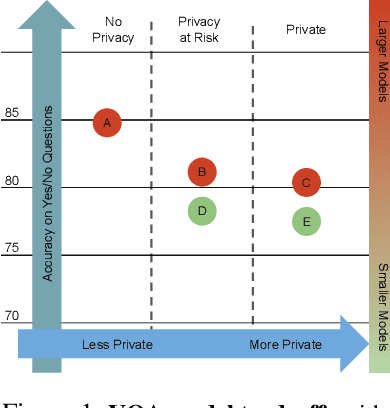

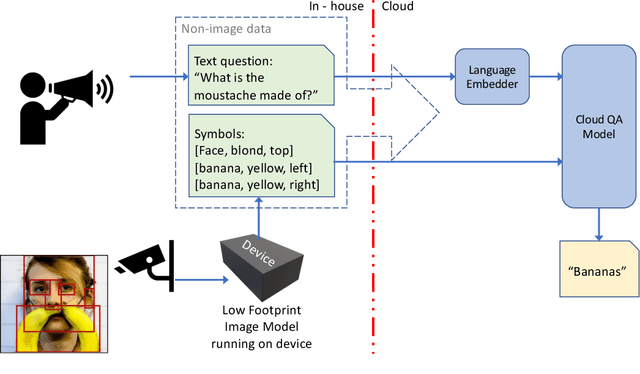

Abstract:We introduce a novel privacy-preserving methodology for performing Visual Question Answering on the edge. Our method constructs a symbolic representation of the visual scene, using a low-complexity computer vision model that jointly predicts classes, attributes and predicates. This symbolic representation is non-differentiable, which means it cannot be used to recover the original image, thereby keeping the original image private. Our proposed hybrid solution uses a vision model which is more than 25 times smaller than the current state-of-the-art (SOTA) vision models, and 100 times smaller than end-to-end SOTA VQA models. We report detailed error analysis and discuss the trade-offs of using a distilled vision model and a symbolic representation of the visual scene.
Unsupervised 3D Pose Estimation with Geometric Self-Supervision
Apr 09, 2019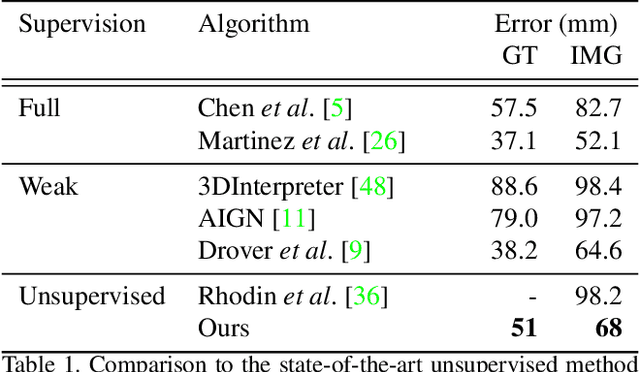

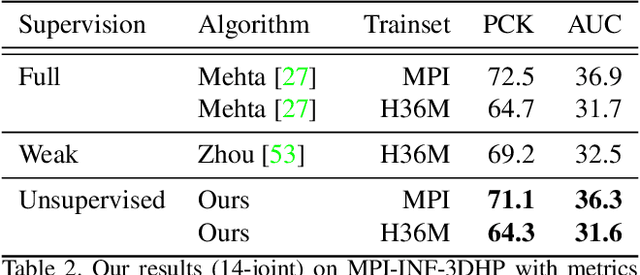
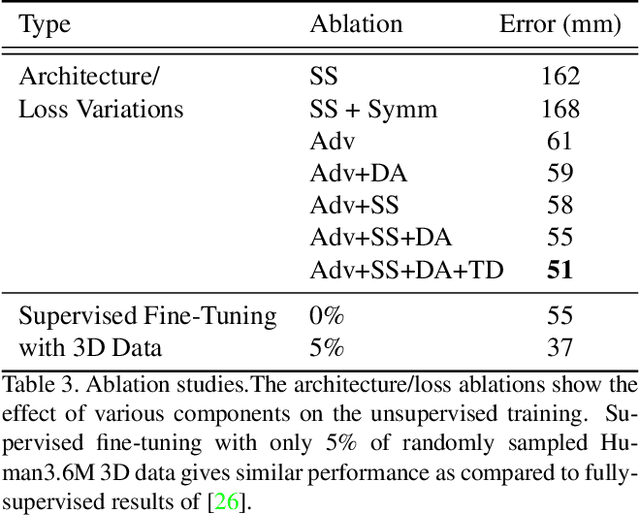
Abstract:We present an unsupervised learning approach to recover 3D human pose from 2D skeletal joints extracted from a single image. Our method does not require any multi-view image data, 3D skeletons, correspondences between 2D-3D points, or use previously learned 3D priors during training. A lifting network accepts 2D landmarks as inputs and generates a corresponding 3D skeleton estimate. During training, the recovered 3D skeleton is reprojected on random camera viewpoints to generate new "synthetic" 2D poses. By lifting the synthetic 2D poses back to 3D and re-projecting them in the original camera view, we can define self-consistency loss both in 3D and in 2D. The training can thus be self supervised by exploiting the geometric self-consistency of the lift-reproject-lift process. We show that self-consistency alone is not sufficient to generate realistic skeletons, however adding a 2D pose discriminator enables the lifter to output valid 3D poses. Additionally, to learn from 2D poses "in the wild", we train an unsupervised 2D domain adapter network to allow for an expansion of 2D data. This improves results and demonstrates the usefulness of 2D pose data for unsupervised 3D lifting. Results on Human3.6M dataset for 3D human pose estimation demonstrate that our approach improves upon the previous unsupervised methods by 30% and outperforms many weakly supervised approaches that explicitly use 3D data.
Can 3D Pose be Learned from 2D Projections Alone?
Aug 22, 2018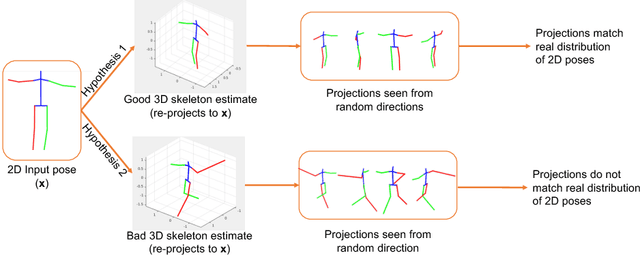



Abstract:3D pose estimation from a single image is a challenging task in computer vision. We present a weakly supervised approach to estimate 3D pose points, given only 2D pose landmarks. Our method does not require correspondences between 2D and 3D points to build explicit 3D priors. We utilize an adversarial framework to impose a prior on the 3D structure, learned solely from their random 2D projections. Given a set of 2D pose landmarks, the generator network hypothesizes their depths to obtain a 3D skeleton. We propose a novel Random Projection layer, which randomly projects the generated 3D skeleton and sends the resulting 2D pose to the discriminator. The discriminator improves by discriminating between the generated poses and pose samples from a real distribution of 2D poses. Training does not require correspondence between the 2D inputs to either the generator or the discriminator. We apply our approach to the task of 3D human pose estimation. Results on Human3.6M dataset demonstrates that our approach outperforms many previous supervised and weakly supervised approaches.
 Add to Chrome
Add to Chrome Add to Firefox
Add to Firefox Add to Edge
Add to Edge